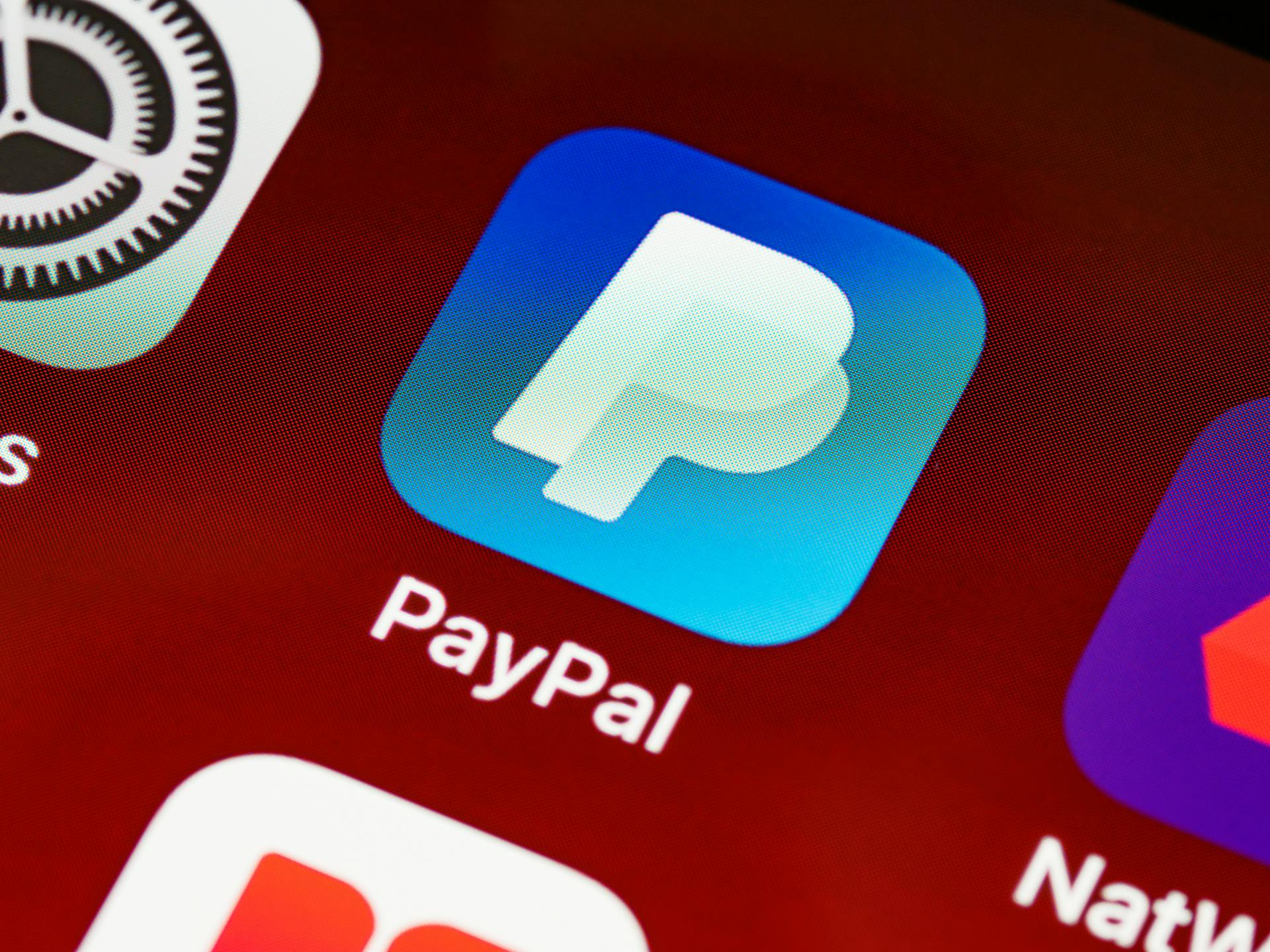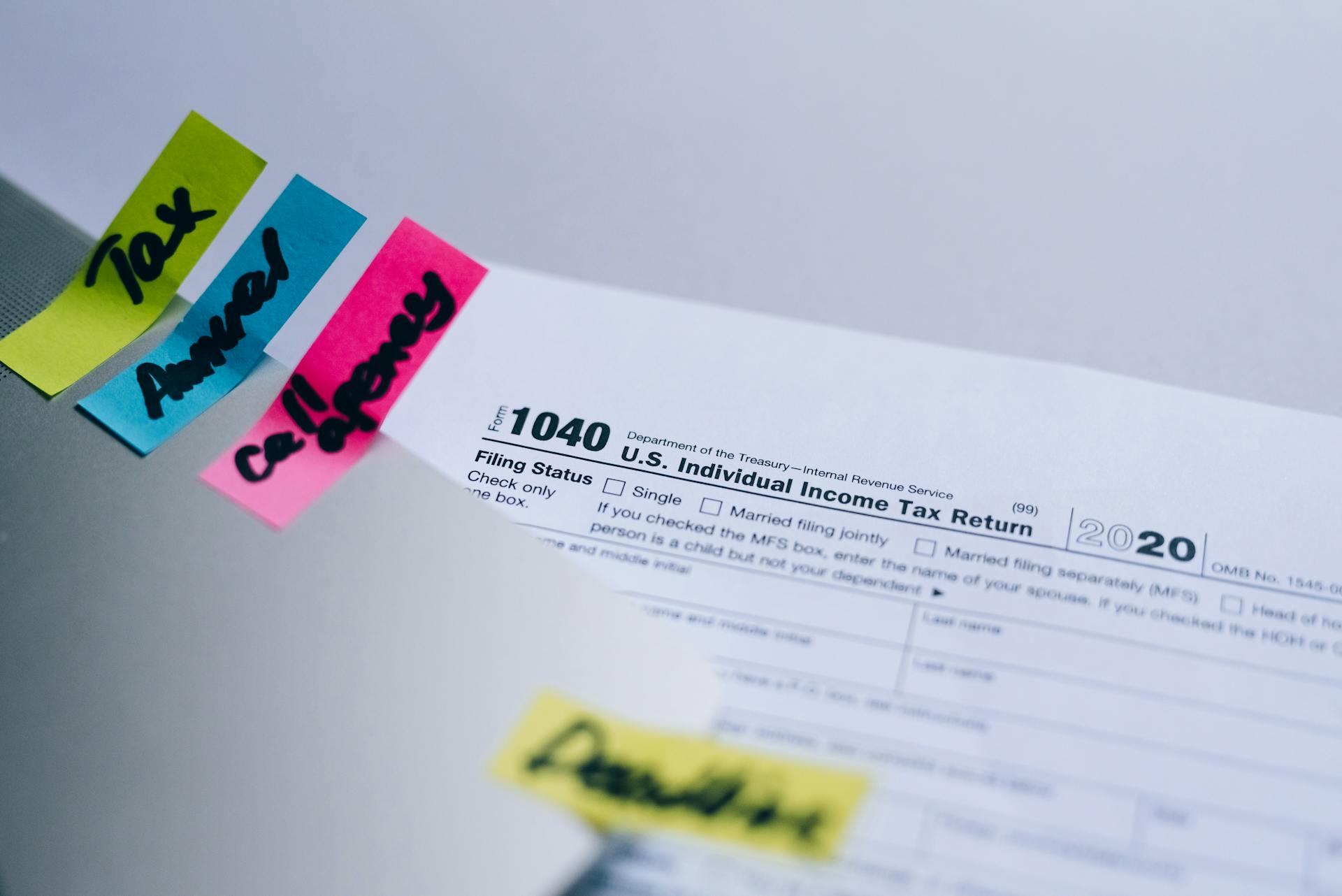
PayPal reports payments to the IRS on Form 1099-K for merchants who receive more than $20,000 in gross payments and have more than 200 transactions in a calendar year.
This threshold applies to payments from all sources, including credit card transactions, online payments, and bank transfers.
Merchants who meet this threshold must report their PayPal payments on their tax return and may be subject to tax on those earnings.
If you're a merchant who receives payments through PayPal, be aware of these reporting requirements to ensure you're in compliance with the IRS.
A fresh viewpoint: Does Pay Pal Do Transactions from Usa to Canada
What is a 1099-K?
A 1099-K is an IRS information return used to report payments received through a payment app, online marketplace, or other payment processor. It's a way for the IRS to keep track of your income.
You'll receive a 1099-K if you receive payments for goods or services through a payment app or online marketplace that exceed the year's 1099-K payment threshold. The threshold is $20,000 in sales and 200 business transactions, according to the IRS.
For your interest: What Is 1099 Tax Form
The 1099-K form will show the total amount of payments for sales you received from the payment app, online marketplace, or payment processor for the tax year. However, it won't include any adjustments for expenses, fees, credits, refunds, shipping, cash equivalents, discounts, costs of goods sold, or the like.
You can expect to receive a 1099-K from payment processors like PayPal, Cash App, and Venmo if you meet the reporting requirements. These requirements are based on the total amount of payments you receive and the number of transactions.
Here's what you can expect to find on a 1099-K form:
- Your name, address, and contact information
- Your tax identification number (TIN)
- The payee's TIN
- The payee's name, address, and contact information
- Gross amount of payment transactions
- Total number of payment transactions
- The merchant category code
- Income earned by the month
- The state and state identification number
- State income taxes withheld
- Federal income taxes withheld
You'll need to include the 1099-K form in your tax filing as proof of income, along with any other relevant self-employment tax documents.
Who Needs to File?
You'll need to file a tax return if you're a business owner who accepts payments through PayPal and meets the federal threshold of $20,000 in total payments and more than 200 transactions in a year.
Related reading: Franchise Tax Board Credit Card Payments
Business owners who receive payments through PayPal should have received a Form 1099-K for the year if they met this threshold, and the form should have arrived by January 31 of the following year.
If you're a business owner who received payments through PayPal in 2023, you should have received a 1099-K form by January 31, 2024, if your total payments were greater than $20,000 and from more than 200 transactions.
Additionally, under IRS rules, you should get a PayPal 1099-K form for the 2024 tax year if your total 2024 payments through the company exceed $5,000, regardless of the number of transactions, and the form should arrive by January 31, 2025.
Some states have their own 1099-K threshold amounts that are lower than the federal threshold, so you may need to file a tax return if you meet the state's threshold, even if you don't meet the federal threshold.
Check this out: How to Pay with Paypal Instead of Shop Pay
Payment Reporting
If you receive a 1099-K form from PayPal, it's essential to understand the payment reporting requirements. You'll need to report the total amount of payments for sales you received from the payment app, online marketplace, or payment processor for the tax year in Box 1a.
Discover more: Btc Payment with Pay Pal
The 1099-K form should show the total amount of payments, but it doesn't include any adjustments for expenses, fees, credits, refunds, shipping, cash equivalents, discounts, costs of goods sold, or the like. So, if you received payments totaling $50,000 through a payment app, but you refunded $5,000 of that amount, your 1099-K form will only report the $50,000 amount.
To calculate your gross income for the year, you'll need to refer to your 1099-K from PayPal, along with any 1099-Ks from other payment apps, credit cards, debit cards, or gift cards. You'll also need to factor in any 1099-NECs (formerly 1099-MISCs) you received from clients or companies that paid you $600 or more directly.
Here are the thresholds for receiving a 1099-K form from PayPal:
- For payments received in 2023, you should have received a Form 1099-K from PayPal if your total payments through the company were greater than $20,000 and from more than 200 transactions.
- For payments received in 2024, you should receive a 1099-K from PayPal if your total 2024 payments through the company exceed $5,000, regardless of the number of transactions.
- Some states have their own 1099-K threshold amounts that are lower than the federal threshold.
Remember, as a 1099 self-employed individual, you're responsible for reporting any income you earn on your taxes, regardless of whether or not you receive a 1099 in the mail.
Additional reading: Bitstamp 1099
What Is Form 1099-K?
Form 1099-K is an IRS information return used to report payments received through a payment app, online marketplace, or other payment processor. It's sent to both the person or business that receives the payments and to the IRS.
You'll receive a 1099-K form from companies like PayPal if you meet certain thresholds, such as receiving payments for goods or services that exceed $20,000 and having more than 200 transactions in a year. These thresholds may vary depending on where you live, so it's worth checking with your state tax agency to see if there are any lower thresholds.
The 1099-K form should show the total amount of payments you received from the payment app, online marketplace, or payment processor for the tax year. However, it's essential to note that this total amount doesn't include any adjustments for expenses, fees, credits, refunds, shipping, cash equivalents, discounts, costs of goods sold, or the like.
Related reading: Taxes for Online Business
Here are the reasons why you might receive a 1099-K form:
- You receive payments for goods or services you provide through a payment app or online marketplace that exceed the year’s 1099-K payment threshold.
- You receive customer credit, debit, or gift card payments through a payment processor, such as a bank or credit card company.
- You receive payments through a payment app, online marketplace, or payment processor and you’re subject to backup withholding.
You can also receive a 1099-K form from other websites, apps, or platforms that facilitate payments for goods and services – such as eBay, Ticketmaster, Etsy, Venmo, Uber, Airbnb, and the like.
Payment Reporting for Friends and Family
Payment reporting for friends and family can be a bit tricky, but don't worry, it's not as complicated as it sounds.
You don't need to report payments from friends and family on your PayPal 1099-K, as long as they're not for goods or services. This means that if your uncle sends you $50 as a birthday gift, or your buddy sends you $100 to reimburse you for a concert ticket, these payments won't trigger a Form 1099-K from PayPal.
To avoid any confusion, it's a good idea to maintain your personal account solely for friends and family transactions and set up a separate business account for commercial transactions.
Curious to learn more? Check out: New Jersey Able Account
If you're already getting a PayPal 1099-K for other reasons, payments from friends and family won't be included in the total payment amount. PayPal users can note whether a payment is either a personal payment to friends or family, or a purchase for goods and services.
Here are the main reasons why payments from friends and family won't be reported on your PayPal 1099-K:
- They're not for goods or services
- They're labeled as "friends and family" payments
By setting up a separate business account and labeling your personal payments correctly, you can avoid any confusion and ensure that your PayPal 1099-K only includes the transactions that need to be reported.
When Is 1099 Sent?
PayPal will send the 1099-K form to you no later than January 31st.
You can expect to receive a physical copy of the form in the mail, as long as you surpass the $20,000 in total payments and 200 or more transactions on the platform for the 2022 tax year.
Consider reading: What Is Irs Form 843
PayPal will also make your 1099-K form available to access directly from your account in the PayPal Statements & Tax Center.
If you don't receive your form by January 31st, get in touch with PayPal's customer support for assistance.
Here's a summary of the key dates to keep in mind:
Common Issues
As a freelancer, you're probably aware that PayPal 1099 can be a bit of a headache. One common issue is receiving incorrect or missing 1099-K forms, which can cause delays in tax filing and even lead to penalties.
Incorrect or missing 1099-K forms can be caused by a mismatch in your PayPal account name and the name on your tax return. Make sure to verify that your PayPal account name matches your legal name and Social Security number.
You can also encounter issues with PayPal's reporting thresholds, which can result in missing 1099-K forms. For instance, if you earn less than $20,000 and have fewer than 200 transactions in a calendar year, PayPal may not issue a 1099-K form.
Curious to learn more? Check out: How to Set up Pay Pal
What If Your Form Is Wrong?

If your PayPal 1099-K form is wrong, contact the company to ask for a corrected form. Keep a record of any correspondence with them.
Contacting PayPal is a straightforward process, and they'll likely send a corrected form if they made the mistake.
Don't wait to file your tax return if the deadline is approaching and you haven't received a new 1099-K from PayPal.
Recommended read: 1099 R Code T Inherited Roth Ira
Avoiding 1099 Misclassification
If you're a small business owner or freelancer, you might be worried about receiving a 1099 form from PayPal or another payment processor. You're not alone. To avoid 1099 misclassification, it's essential to understand the rules.
The IRS requires payment processors like PayPal to send 1099-K forms to users who exceed $20,000 in total payments and have 200 or more transactions on the platform.
As a small business owner, you're responsible for reporting your income accurately, regardless of whether or not you receive a 1099 form. If your gross income falls below $600, you'll need to file a 1099-NEC on your own.
Curious to learn more? Check out: Unrelated Business Income Taxes
You can find your 1099-K forms in the PayPal Statements & Tax Center via your PayPal account. Make sure all your information is accurate before the deadline to guarantee you receive the form on time.
Here's a quick rundown of the 1099-K threshold rules:
If you're unsure about your 1099 status, it's always best to check with PayPal or consult with a tax professional. Remember, accurate reporting is key to avoiding any issues with the IRS.
Tax Obligations
As a PayPal user, it's essential to understand your tax obligations. You're only taxed on profits from your business or occasional sales of goods or services, not the total amount of payments reported on Form 1099-K.
To calculate your taxable income, you'll need to subtract the cost of any property sold, along with deductible business expenses, from the total payments shown on your Form 1099-K. For example, if you sold an item for $30,000 and paid $25,000 for it, your taxable income would be $4,900 ($30,000 - $25,000 = $4,900).
Check this out: Are High Corporate Income Taxes Bad
You can report your taxable income on Schedule C (Form 1040) if you're a sole proprietor, or on Form 8949, which will carry over to Schedule D (Form 1040) if you're not a business owner.
Here are the key forms and schedules to report your PayPal income:
Remember to also report any income you didn't receive a 1099-K or 1099-NEC for, as you're still required to pay income taxes on it.
You might enjoy: Company Car Income Tax
Do You Owe Tax on 1099-K Payments?
You only owe tax on the profits from your business or the occasional sale of goods or services, not the total amount of payments reported on Form 1099-K.
Form 1099-K shows the total amount of payments received from a payment app, online marketplace, or payment processor during the year, but that's not the same as your taxable income.
You can subtract the cost of acquiring any property sold, along with any deductible business expenses, from the total payments to arrive at your taxable income.
Explore further: Email Sent Btc Payment with Pay Pal
For example, if you sell an item for $30,000 and paid $25,000 for it, plus $100 for shipping, your taxable income would be $4,900 ($30,000 - $25,000 - $100 = $4,900).
If you're operating a business as a sole proprietor, report the taxable portion of your PayPal 1099-K payments on Schedule C (Form 1040), where you report all your business income and subtract all your business expenses.
If you're not a business owner, report any profit from the sale on Form 8949, which will carry over to Schedule D (Form 1040), and it will be reported as a capital gain on your federal tax return.
Curious to learn more? Check out: Can You Pay in 4 with Shop Pay
Filing Taxes Guide
You'll need to report your self-employment income to the IRS, which can be a complex task. Knowing how to manage self-employment tax and 1099 income is crucial for avoiding costly errors.
To file your self-employment taxes, you'll need to gather all your 1099 forms, including Form 1099-K from PayPal and any 1099-NECs from clients or companies that paid you $600 or more directly.
Familiarize yourself with the different types of 1099 forms, their functions, and the filing requirements to ensure correct tax reporting and compliance.
To calculate your gross income for the year, you'll need to refer to your 1099-K from PayPal, along with any 1099-Ks from other payment apps, credit cards, debit cards, or gift cards.
You'll also need to factor in any 1099-NECs you received from clients or companies that paid you $600 or more directly, via electronic fund transfer, direct deposit, cash, or checks.
Here's a step-by-step guide to help you determine your gross income:
- Gather your 1099-K, 1099-NECs, and bank statements
- Add up any income that you didn't receive either a 1099-K or a 1099-NEC for
- Include payments from other clients that paid you less than $600 for the year
Once you have all your 1099 forms in hand, you're ready to file your self-employment taxes. You can use accounting software to help you accurately categorize your expenses and keep track of customer payments.
To file your PayPal income, follow these three steps:
Additional reading: Can You File Self Employment Taxes without a Business License
1. Gather all your 1099 forms
2. Calculate your gross income for the year
3. Report your income on Schedule C (Form 1040) if you're a business owner, or on Form 8949 if you're not a business owner
Remember, you're only taxed on any profits from your business or the occasional sale of goods or services.
Discover more: Pay Pal Owner
Self-Employed Taxes
As a self-employed individual, taking care of your taxes can be a daunting task. The IRS defines a self-employed person as someone earning income from an independent economic activity and is responsible for collecting self-employment taxes.
The IRS imposes penalties for not reporting 1099 and taxes income, so it's essential to submit your 1099 income to the IRS on time to avoid these harsh penalties.
Familiarize yourself with the several kinds of 1099 forms, their functions, and the filing requirements to guarantee correct tax reporting and compliance.
You can file your self-employment taxes once you have all of your 1099 forms in hand.
To reduce your tax liability, you can deduct business-related expenses from your annual income by filing a Schedule C. This includes expenses such as accounting fees, third-party payment processing fees, and marketing and advertising costs.
Here are some common business expenses that are fully tax deductible:
- Accounting fees
- Third-party payment processing fees
- Marketing and advertising costs
- Continuing education expenses
- Payments to contract workers
- Payroll expenses
- Software subscriptions
- Domain names and website hosting
- Legal fees
- Rent
- Office equipment
You can also deduct expenses if you were actively engaged in business activities and didn't earn any income, as long as each eligible expense is considered an ordinary and necessary expense by the IRS.
IRS Requirements
To avoid any potential penalties, it's essential to understand the IRS requirements for PayPal sellers. You'll only receive a 1099-K form from PayPal if you made more than $20,000 and had over 200 transactions in a year.
For the 2023 tax season, the threshold for receiving a 1099-K form will be lowered to $600, meaning you'll be required to report and pay taxes on those earnings. This change will go into effect for the 2023 tax season.
Even if you don't receive a 1099-K form, all your business income is still taxable, so be sure to report it accordingly. You should be on the lookout for a PayPal 1099-K if you've used PayPal for your business and surpassed the 2022 thresholds.
As a self-employed person, you're responsible for collecting self-employment taxes and managing your own tax reporting, which can be a complex task. To guarantee correct tax reporting and compliance, familiarize yourself with the different types of 1099 forms and their filing requirements.
Reporting and Double-Reporting
Reporting and Double-Reporting is a common issue for freelancers and small business owners who use PayPal for their transactions. Double-reporting occurs when some of your income is inadvertently reported twice to the IRS.
This can happen when a client pays you via PayPal and then issues you a 1099-NEC. This can appear as though you are reporting double the actual income received from the client.
Readers also liked: When Should You Pay a Roofer?
For example, a consultant may invoice a client via PayPal for services provided and receive a 1099-K from PayPal, but then the client issues a 1099-NEC for the same payments. It will appear to the IRS as though the consultant earned double the actual revenue.
You can deal with double-reporting and avoid double taxation by separating your business and personal transactions, and keeping detailed records of your business income.
Thresholds and Selling
You'll receive a 1099 from PayPal if your annual sales meet a certain threshold, but if your yearly income from a particular client falls below $600, they may not send you a 1099.
Any money you earn on PayPal is considered taxable, regardless of whether or not you receive a 1099 in the mail.
If your gross income falls below $600 in a calendar year, you'll need to file the 1099-NEC on your own.
Related reading: The One Fixed Asset That Is Not Depreciated Is
Selling Threshold for 1099
If your annual sales on PayPal are relatively low, there's a chance you won't receive a 1099. Any money you earn is considered taxable, regardless of whether or not you receive a 1099 in the mail.
To receive a 1099-NEC, your gross income doesn't have to be a specific amount, but if it falls below $600 in a calendar year, you'll file the 1099-NEC on your own.
The 1099-K is an income summary that payment processors like PayPal provide to anyone who meets specific criteria for business transactions conducted on the platform.
For PayPal, the threshold for receiving a 1099-K is now $20,000 in sales on the platform, and you must have completed at least 200 business transactions.
Here are the current requirements for receiving a 1099-K from PayPal:
Garage Sale Selling
Garage sales can be a great way to declutter and make some extra cash, but did you know that income from garage sales is not considered taxable? This is because selling goods as a hobby is considered non-taxable.
If you're using PayPal for your garage sale transactions, you might still receive a 1099-K, even if the income shouldn't be taxable. This can be confusing, so it's a good idea to ask a CPA for help.
Some income received through PayPal, like reselling old office furniture or getting rid of clutter on Facebook marketplace, may not be considered taxable profits. Just make sure to keep track of your transactions and consult with a tax professional if needed.
Filing and Calculations
You've got your 1099 forms in hand, and now it's time to file your self-employment taxes. This is a crucial step in the process.
Once you have your 1099 forms, you're ready to file your PayPal income. Here are three steps you'll take to file your income taxes: First, you'll gather all necessary documents, including your 1099 forms and any other relevant tax paperwork.
You'll need to have all of your 1099 forms in hand before you can file your self-employment taxes.
FAQs About Forms
You'll receive a 1099-K from PayPal if you received over $20,000 in total payments for goods and services and had 200 or more transactions on the platform, or if you received over $600 in payments for goods and services.
PayPal will send your 1099-K by January 31, giving you plenty of time to file before the tax deadline.
You don't need to send a 1099-K to anyone - this form is sent by third-party payment networks like PayPal and Venmo to users meeting the requirements for the related tax year.
For your interest: Pay Pal Goods and Services Fee
Small business owners don't send 1099-Ks, they just receive them from payment networks.
If you're a freelance writer or have a small business, you'll need to refer to your 1099-K from PayPal, along with any other relevant forms, to determine your gross income for the year.
You can find your 1099-K forms by accessing the PayPal Statements & Tax Center via your PayPal account, or PayPal will mail you a physical copy if you surpass the reporting thresholds.
Some states have lower 1099-K threshold amounts than the federal threshold, so you should check with your state tax agency to see if you're eligible for a 1099-K.
Financial gifts or reimbursements received from family and friends don't count toward the thresholds for receiving a 1099-K.
A different take: Pay T Mobile by Apple Pay Cash Back
Frequently Asked Questions
What is the $600 rule on PayPal?
On PayPal, a tax ID hold is applied to accounts receiving $600 or more in payments within a 12-month period, requiring users to confirm their taxpayer status within 60 days
Will I get a 1099 from PayPal in 2024?
You'll receive a 1099-K form from PayPal in 2025 if your total 2024 payments exceed $5,000, regardless of the number of transactions. Check the IRS rules for more information on PayPal 1099-K forms.
How to avoid PayPal 1099?
To avoid PayPal 1099 forms, keep your gross income below the IRS reporting threshold ($5,000 in 2024). However, even below this threshold, you still need to report and pay taxes on your earnings.
Sources
Featured Images: pexels.com


